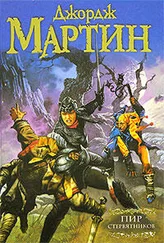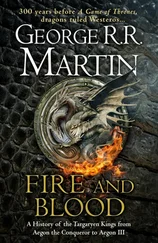Though the court and city still doted on the king’s brother, that clever, gallant boy Viserys, the same could not be said for his Lysene wife. Larra Rogare had taken up residence in the Red Keep with her husband, yet in her heart she remained a lady of Lys. Though fluent in High Valyrian and the dialects of Myr, Tyrosh, and Old Volantis in addition to her own Lysene tongue, Lady Larra made no effort to learn the Common Tongue, preferring to rely upon translators to make her wishes known. Her ladies were all Lyseni, as were her servants. The gowns she wore all came from Lys, even her smallclothes; her father’s ships delivered the latest Lysene fashions to her thrice a year. She even had her own protectors. Lysene swords guarded her night and day, under the command of her brother Moredo and a towering mute from the fighting pits of Meereen called Sandoq the Shadow.
All this the court and kingdom might have come to accept in time, had Lady Larra not also insisted upon keeping her own gods. She would have no part in the worship of the Seven, nor the old gods of the northmen. Her worship was reserved for certain of the manifold gods of Lys: the six-breasted cat goddess Pantera, Yndros of the Twilight who was male by day and female by night, the pale child Bakkalon of the Sword, faceless Saagael, the giver of pain.
Her ladies, her servants, and her guards would join Lady Larra at certain times in performing obeisances to these queer, ancient deities. Cats were seen coming and going from her chambers so often that men began to say they were her spies, purring at her in soft voices of all the doings of the Red Keep. It was even said that Larra herself could transform into a cat, to prowl the gutters and rooftops of the city. Darker rumors soon arose. The acolytes of Yndros could supposedly transform themselves from male to female and female to male through the act of love, and whispers went about that her ladyship oft availed herself of this ability at twilight orgies, so she might visit the brothels on the Street of Silk as a man. And every time a child went missing, the ignorant would look at one another and talk of Saagael’s insatiable thirst for blood.
Even less loved than Larra of Lys were the three brothers who had come with her to King’s Landing. Moredo commanded his sister’s guards, whilst Lotho set about establishing a branch of the Rogare Bank atop Visenya’s Hill. Roggerio, the youngest, opened an opulent Lysene pillow house called the Mermaid beside the River Gate, and filled it with parrots from the Summer Islands, monkeys from Sothoryos, and a hundred exotic girls (and boys) from every corner of the earth. Though their favors cost ten times as much as any other brothel dared to charge, Roggerio never lacked for customers. Great lords and common tradesmen alike spoke of the beauties and wonders to be found behind the Mermaid’s carved and painted doors…including, some said, an actual mermaid. (Almost all that we know of the myriad marvels of the Mermaid comes to us from Mushroom, who alone amongst our chroniclers is willing to confess to visiting the brothel himself on many occasions and partaking of its many pleasures in sumptuously appointed rooms.)
Across the sea, the Daughters’ War finally reached its end. Racallio Ryndoon fled south to the Basilisk Isles with his remaining supporters; Lys, Tyrosh, and Myr divided the Disputed Lands; and the Dornish took dominion over most of the Stepstones. The Myrish suffered the greatest losses in these new arrangements, whilst the Archon of Tyrosh and the Princess of Dorne gained the most. In Lys, ancient houses fell and many a highborn magister was cast down and ruined, whilst others rose up to seize the reins of power. Chief amongst these was Lysandro Rogare and his brother Drazenko, architect of the Dornish alliance. Drazenko’s ties to Sunspear and Lysandro’s to the Iron Throne made the Rogares the princes of Lys in all but name.
By the end of 134 AC, some feared they might soon rule Westeros as well. Their pride and pomp and power became the talk of King’s Landing. Men began to whisper of their wiles. Lotho bought men with gold, Roggerio seduced them with perfumed flesh, Moredo frightened them into submission with steel. Yet the brothers were no more than puppets in the hands of Lady Larra; it was her and her queer Lysene gods who held their strings. The king, the little queen, the young prince…they were only children, blind to what was happening about them, whilst the Kingsguard and the gold cloaks and even the King’s Hand had been bought and sold.
Or so the stories went. Like all such tales, they had some truth to them, well mixed with fear and falsehood. That the Lyseni were proud, grasping, and ambitious cannot be doubted. That Lotho used his bank and Roggerio his brothel to win friends to their cause goes without saying. Yet in the end they differed but little from many of the other lords and ladies of Aegon III’s court, all of them pursuing power and wealth in their own ways. Though more successful than their rivals (for a time, at least), the Lyseni were only one of several factions competing for influence. Had Lady Larra and her brothers been Westerosi, they might have been admired and celebrated, but their foreign birth, foreign ways, and foreign gods made them objects of mistrust and suspicion instead.
Munkun refers to this period as the Rogare Ascendency, but that term was only ever used at Oldtown, amongst the maesters and archmaesters of the Citadel. The people who lived through it called it the Lysene Spring…for spring was indeed a part of it. Early in 135 AC, the Conclave sent forth its white ravens from Oldtown to herald the end of one of the longest and cruelest winters that the Seven Kingdoms had ever known.
Spring is ever a season of hope, rebirth, and renewal, and the spring of 135 AC was no different. The war in the Iron Islands came to an end, and Lord Cregan Stark of Winterfell borrowed a huge sum from the Iron Bank of Braavos to buy food and seed for his starving smallfolk. Only in the Vale did fighting continue. Furious at the refusal of the Arryn claimants to come to King’s Landing and submit their dispute to the judgment of the regents, Lord Thaddeus Rowan sent a thousand men to Gulltown under the command of his fellow regent, Ser Corwyn Corbray, to restore the King’s Peace and settle the matter of succession.
Meanwhile, King’s Landing experienced a period of prosperity such as it had not seen in many years, in no small part thanks to House Rogare of Lys. The Rogare Bank was paying rich returns on all the monies deposited with them, leading more and more lords to entrust the Lyseni with their gold. Trade flourished as well, as ships from Tyrosh, Myr, Pentos, Braavos, and especially Lys crowded the docks along the Blackwater, offloading silks and spices, Myrish lace, jade from Qarth, ivory from Sothoryos, and many other strange and wondrous things from the ends of the earth, including luxuries seldom seen in the Seven Kingdoms before.
Other port towns shared in the bounty; Duskendale, Maidenpool, Gulltown, and White Harbor saw their trade expand as well, as did Oldtown to the south, and even Lannisport upon the sunset sea. On Driftmark, the town of Hull experienced a rebirth. Scores of new ships were built and launched, and Lord Oakenfist’s mother greatly expanded her own trading fleets, and began work on a palatial manse overlooking the harbor that Mushroom dubbed the Mouse House.
Across the narrow sea, Lys itself was prospering under the “velvet tyranny” of Lysandro Rogare, who had taken on himself the style of First Magister for Life. And when his brother Drazenko married Princess Aliandra Martell of Dorne, and was named by her Prince Consort and Lord of the Stepstones, the ascendancy of House Rogare reached its apex. Men began to speak of Lysandro the Magnificent.
Читать дальше




![Джордж Мартин - Сыны Дракона [лп]](/books/33039/dzhordzh-martin-syny-drakona-lp-thumb.webp)







